Denon DVD-1910, DVD-755 Service Manual
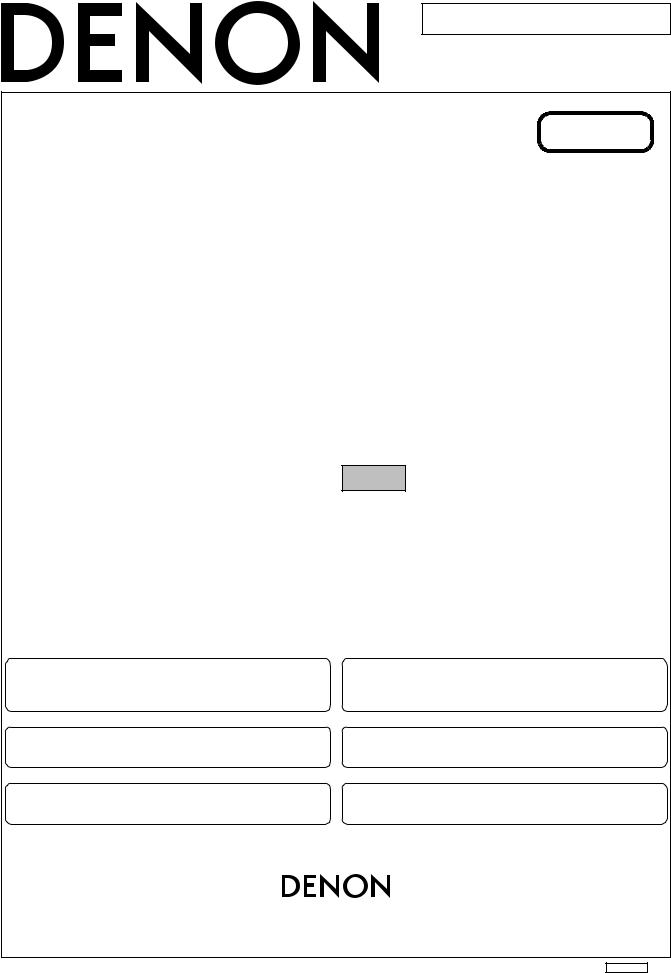
For U.S.A. & Canada model
Ver. 3
SERVICE MANUAL
MODEL DVD-1910
DVD-755
DVD VIDEO PLAYER
|
●For purposes of improvement, specifications and design are subject to change without notice.
●Please use this service manual with referring to the operating instructions without fail.
●Some illustrations using in this service manual are slightly different from the actual set.
● ● 8
●
●
TOKYO, JAPAN
Denon Brand Company, D&M Holdings Inc.
X0217V.03 DE/CDM 0508

DVD-1910/755
TABLE OF CONTENTS
SPECIFICATIONS . . . . . . . . . . . . . . . . . . . . . . . . . . . . . . . . . . . . . . . . . . . . . . . . . . . . . . . . . . . . . . . . . . . . . . . . . . . 3 LASER BEAM SAFETY PRECAUTIONS . . . . . . . . . . . . . . . . . . . . . . . . . . . . . . . . . . . . . . . . . . . . . . . . . . . . . . . . . . 4 IMPORTANT SAFETY PRECAUTIONS . . . . . . . . . . . . . . . . . . . . . . . . . . . . . . . . . . . . . . . . . . . . . . . . . . . . . . . . . . . 5 STANDARD NOTES FOR SERVICING . . . . . . . . . . . . . . . . . . . . . . . . . . . . . . . . . . . . . . . . . . . . . . . . . . . . . . . . . . . 7 CABINET DISASSEMBLY INSTRUCTIONS . . . . . . . . . . . . . . . . . . . . . . . . . . . . . . . . . . . . . . . . . . . . . . . . . . . . . . 11 TROUBLESHOOTING . . . . . . . . . . . . . . . . . . . . . . . . . . . . . . . . . . . . . . . . . . . . . . . . . . . . . . . . . . . . . . . . . . . . . . . 15 BLOCK DIAGRAMS . . . . . . . . . . . . . . . . . . . . . . . . . . . . . . . . . . . . . . . . . . . . . . . . . . . . . . . . . . . . . . . . . . . . . . . . . 21 SCHEMATIC DIAGRAMS / CBA’S AND TEST POINTS. . . . . . . . . . . . . . . . . . . . . . . . . . . . . . . . . . . . . . . . . . . . . . 26 WAVEFORMS. . . . . . . . . . . . . . . . . . . . . . . . . . . . . . . . . . . . . . . . . . . . . . . . . . . . . . . . . . . . . . . . . . . . . . . . . . . . . . 37 WIRING DIAGRAMS. . . . . . . . . . . . . . . . . . . . . . . . . . . . . . . . . . . . . . . . . . . . . . . . . . . . . . . . . . . . . . . . . . . . . . . . . 38 FIRMWARE RENEWAL MODE . . . . . . . . . . . . . . . . . . . . . . . . . . . . . . . . . . . . . . . . . . . . . . . . . . . . . . . . . . . . . . . . 39 LEAD IDENTIFICATIONS. . . . . . . . . . . . . . . . . . . . . . . . . . . . . . . . . . . . . . . . . . . . . . . . . . . . . . . . . . . . . . . . . . . . . 40 EXPLODED VIEWS . . . . . . . . . . . . . . . . . . . . . . . . . . . . . . . . . . . . . . . . . . . . . . . . . . . . . . . . . . . . . . . . . . . . . . . . . 41 PARTS LIST . . . . . . . . . . . . . . . . . . . . . . . . . . . . . . . . . . . . . . . . . . . . . . . . . . . . . . . . . . . . . . . . . . . . . . . . . . . . . . . 43
Manufactured under license from Dolby Laboratories. "Dolby" and the double-D symbol are trademarks of Dolby Laboratories.
2

DVD-1910/755
SPECIFICATIONS
|
|
ITEM |
CONDITIONS |
UNIT |
NOMINAL |
LIMIT |
|
|
|
|
|
|
|
|
|
|
|
|
|
|
1. |
Video Output |
75 ohm load |
Vpp |
1.0 |
± 0.1 |
|
|
|
|
|
|
|
|
2. |
Optical Digital Out |
|
dBm |
-18 |
|
|
|
|
|
|
|
|
|
3. |
Audio (PCM) |
|
|
|
|
|
|
|
|
|
|
|
|
|
3-1. |
Output Level |
1 kHz 0 dB |
Vrms |
2.0 |
|
|
|
|
|
|
|
|
|
3-2. |
S/N |
|
dB |
115 |
|
|
|
|
|
|
|
|
|
3-3. |
Freq. Response |
|
|
|
|
|
|
|
|
|
|
|
|
|
DVD |
fs=48kHz ± 0.5dB |
Hz |
4~22 k |
|
|
|
|
|
|
|
|
|
|
CD |
fs=44.1kHz ± 0.5dB |
Hz |
4~20 k |
|
|
|
|
|
|
|
|
|
3-4. |
THD+N |
|
|
|
|
|
|
|
|
|
|
|
|
|
DVD |
1 kHz 0dB |
% |
0.004 |
|
|
|
|
|
|
|
|
|
|
CD |
1 kHz 0dB |
% |
0.0045 |
|
|
|
|
|
|
|
|
NOTES:
1.All Items are measured without pre-emphasis unless otherwise specified.
2.Power supply : AC120 V 60 Hz
3.Load imp. : 100 k ohm
4.Ambient Temperature : +25 °C
3

DVD-1910/755
LASER BEAM SAFETY PRECAUTIONS
This DVD player uses a pickup that emits a laser beam.
Do not look directly at the laser beam coming from the pickup or allow it to strike against your skin.
The laser beam is emitted from the location shown in the figure. When checking the laser diode, be sure to keep your eyes at least 30cm away from the pickup lens when the diode is turned on. Do not look directly at the laser beam.
Caution: Use of controls and adjustments, or doing procedures other than those specified herein, may result in hazardous radiation exposure.
Drive Mecha Assembly
Laser Beam Radiation
Laser Pickup
Turntable 
CAUTION
LASER RADIATION
WHEN OPEN. DO NOT
STARE INTO BEAM.
Location: Top of DVD mechanism.
4

DVD-1910/755
IMPORTANT SAFETY PRECAUTIONS
Product Safety Notice
Some electrical and mechanical parts have special safety-related characteristics which are often not evident from visual inspection, nor can the protection they give necessarily be obtained by replacing them with components rated for higher voltage, wattage, etc. Parts that have special safety characteristics are identi-
fied by a  on schematics and in parts lists. Use of a substitute replacement that does not have the same safety characteristics as the recommended replacement part might create shock, fire, and/or other hazards. The Product’s Safety is under review continuously and new instructions are issued whenever appropriate. Prior to shipment from the factory, our products are carefully inspected to confirm with the recognized product safety and electrical codes of the countries in which they are to be sold. However, in order to maintain such compliance, it is equally important to implement the following precautions when a set is being serviced.
on schematics and in parts lists. Use of a substitute replacement that does not have the same safety characteristics as the recommended replacement part might create shock, fire, and/or other hazards. The Product’s Safety is under review continuously and new instructions are issued whenever appropriate. Prior to shipment from the factory, our products are carefully inspected to confirm with the recognized product safety and electrical codes of the countries in which they are to be sold. However, in order to maintain such compliance, it is equally important to implement the following precautions when a set is being serviced.
Precautions during Servicing
A.Parts identified by the  symbol are critical for safety. Replace only with part number specified.
symbol are critical for safety. Replace only with part number specified.
B.In addition to safety, other parts and assemblies are specified for conformance with regulations applying to spurious radiation. These must also be replaced only with specified replacements.
Examples: RF converters, RF cables, noise blocking capacitors, and noise blocking filters, etc.
C.Use specified internal wiring. Note especially:
1)Wires covered with PVC tubing 2)Double insulated wires
3)High voltage leads
D.Use specified insulating materials for hazardous live parts. Note especially:
1)Insulation tape 2)PVC tubing 3)Spacers
4)Insulators for transistors
K.Crimp type wire connector
The power transformer uses crimp type connectors which connect the power cord and the primary side of the transformer. When replacing the transformer, follow these steps carefully and precisely to prevent shock hazards.
Replacement procedure
1)Remove the old connector by cutting the wires at a point close to the connector.
Important: Do not re-use a connector. (Discard it.)
2)Strip about 15 mm of the insulation from the ends of the wires. If the wires are stranded, twist the strands to avoid frayed conductors.
3)Align the lengths of the wires to be connected. Insert the wires fully into the connector.
4)Use a crimping tool to crimp the metal sleeve at its center. Be sure to crimp fully to the complete closure of the tool.
L.When connecting or disconnecting the internal connectors, first, disconnect the AC plug from the AC outlet.
E.When replacing AC primary side components (transformers, power cord, etc.), wrap ends of wires securely about the terminals before soldering.
F.Observe that the wires do not contact heat producing parts (heatsinks, oxide metal film resistors, fusible resistors, etc.).
G.Check that replaced wires do not contact sharp edges or pointed parts.
H.When a power cord has been replaced, check that 5 - 6 kg of force in any direction will not loosen it.
I.Also check areas surrounding repaired locations.
J.Be careful that foreign objects (screws, solder droplets, etc.) do not remain inside the set.
5

Safety Check after Servicing
Examine the area surrounding the repaired location for damage or deterioration. Observe that screws, parts, and wires have been returned to their original positions. Afterwards, do the following tests and confirm the specified values to verify compliance with safety standards.
1. Clearance Distance
When replacing primary circuit components, confirm specified clearance distance (d) and (d’) between soldered terminals, and between terminals and surrounding metallic parts. (See Fig. 1)
Table 1: Ratings for selected area
AC Line Voltage |
Clearance Distance (d), (d’) |
|
|
120 V |
≥ 3.2mm (0.126 inches) |
|
|
Note: This table is unofficial and for reference only. Be sure to confirm the precise values.
2. Leakage Current Test
Confirm the specified (or lower) leakage current between B (earth ground, power cord plug prongs) and externally exposed accessible parts (RF terminals, antenna terminals, video and audio input and output terminals, microphone jacks, earphone jacks, etc.) is lower than or equal to the specified value in the table below.
Measuring Method (Power ON) :
Insert load Z between B (earth ground, power cord plug prongs) and exposed accessible parts. Use an AC voltmeter to measure across the terminals of load Z. See Fig. 2 and the following table.
Table 2: Leakage current ratings for selected areas
|
DVD-1910/755 |
Chassis or Secondary Conductor |
|
Primary Circuit Terminals |
|
d' |
d |
Fig. 1
 Exposed Accessible Part
Exposed Accessible Part
Z
1.5k |
|
AC Voltmeter |
|
0.15 F |
(High Impedance) |
||
|
|||
|
|
BEarth Ground
Power Cord Plug Prongs
Fig. 2
AC Line Voltage |
Load Z |
Leakage Current (i) |
Earth Ground (B) to: |
|
120 V |
0.15µF CAP. & 1.5kΩ RES. |
i≤0.5mA Peak |
Exposed accessible parts |
|
Connected in parallel |
||||
|
|
|
Note: This table is unofficial and for reference only. Be sure to confirm the precise values.
6
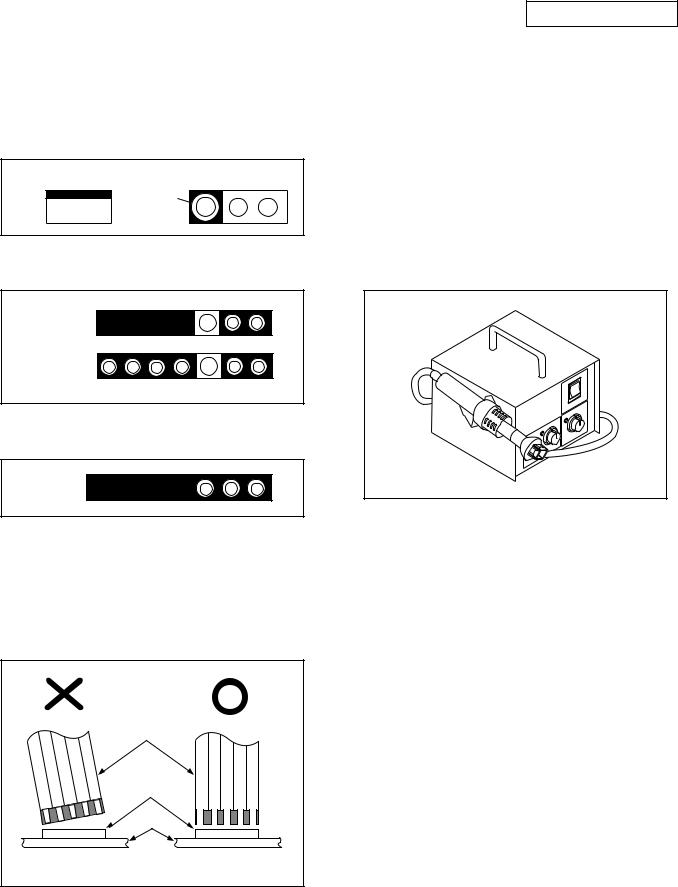
DVD-1910/755
STANDARD NOTES FOR SERVICING
Circuit Board Indications
1.The output pin of the 3 pin Regulator ICs is indicated as shown.
Pb (Lead) Free Solder
When soldering, be sure to use the Pb free solder.
Top View |
|
Bottom View |
Out |
In |
Input |
|
2.For other ICs, pin 1 and every fifth pin are indicated as shown.
5
Pin 1 






10
3.The 1st pin of every male connector is indicated as shown.
Pin 1 




Instructions for Connectors
1.When you connect or disconnect the FFC (Flexible Foil Connector) cable, be sure to first disconnect the AC cord.
2.FFC (Flexible Foil Connector) cable should be inserted parallel into the connector, not at an angle.
How to Remove / Install Flat Pack-IC
1. Removal
With Hot-Air Flat Pack-IC Desoldering Machine:.
(1)Prepare the hot-air flat pack-IC desoldering machine, then apply hot air to the Flat Pack-IC (about 5 to 6 seconds). (Fig. S-1-1)
Fig. S-1-1
(2)Remove the flat pack-IC with tweezers while applying the hot air.
(3)Bottom of the flat pack-IC is fixed with glue to the CBA; when removing entire flat pack-IC, first apply soldering iron to center of the flat pack-IC and heat up. Then remove (glue will be melted). (Fig. S-1-6)
(4)Release the flat pack-IC from the CBA using tweezers. (Fig. S-1-6)
FFC Cable
Connector
CBA
Caution:
1.The Flat Pack-IC shape may differ by models. Use an appropriate hot-air flat pack-IC desoldering machine, whose shape matches that of the Flat Pack-IC.
2.Do not supply hot air to the chip parts around the flat pack-IC for over 6 seconds because damage to the chip parts may occur. Put masking tape around the flat pack-IC to protect other parts from damage. (Fig. S-1-2)
* Be careful to avoid a short circuit.
7

3.The flat pack-IC on the CBA is affixed with glue, so be careful not to break or damage the foil of each pin or the solder lands under the IC when removing it.
|
Hot-air |
|
Flat Pack-IC |
|
Desoldering |
CBA |
Machine |
|
|
Masking |
Flat Pack-IC |
Tape |
|
Tweezers |
|
|
Fig. S-1-2 |
DVD-1910/755
With Soldering Iron:
(1)Using desoldering braid, remove the solder from all pins of the flat pack-IC. When you use solder flux which is applied to all pins of the flat pack-IC, you can remove it easily. (Fig. S-1-3)
Flat Pack-IC |
Desoldering Braid |
|
Soldering Iron
Fig. S-1-3
(2)Lift each lead of the flat pack-IC upward one by one, using a sharp pin or wire to which solder will not adhere (iron wire). When heating the pins, use a fine tip soldering iron or a hot air desoldering machine. (Fig. S-1-4)
Sharp
 Pin
Pin
Fine Tip 
Soldering Iron
Fig. S-1-4
(3)Bottom of the flat pack-IC is fixed with glue to the CBA; when removing entire flat pack-IC, first apply soldering iron to center of the flat pack-IC and heat up. Then remove (glue will be melted). (Fig. S-1-6)
(4)Release the flat pack-IC from the CBA using tweezers. (Fig. S-1-6)
8
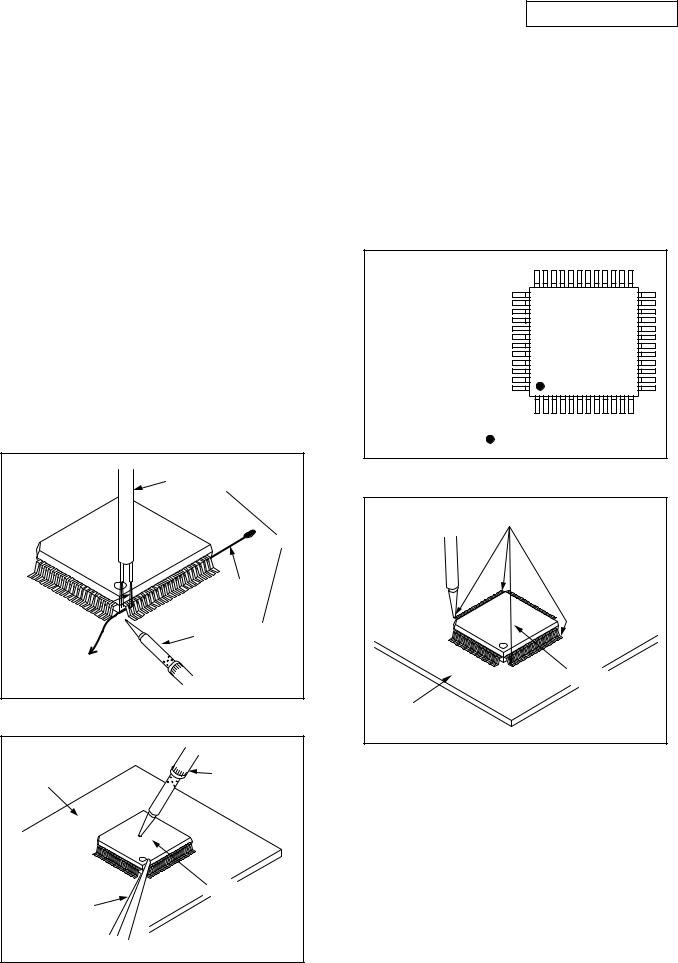
With Iron Wire:
(1)Using desoldering braid, remove the solder from all pins of the flat pack-IC. When you use solder flux which is applied to all pins of the flat pack-IC, you can remove it easily. (Fig. S-1-3)
(2)Affix the wire to a workbench or solid mounting point, as shown in Fig. S-1-5.
(3)While heating the pins using a fine tip soldering iron or hot air blower, pull up the wire as the solder melts so as to lift the IC leads from the CBA contact pads as shown in Fig. S-1-5.
(4)Bottom of the flat pack-IC is fixed with glue to the CBA; when removing entire flat pack-IC, first apply soldering iron to center of the flat pack-IC and heat up. Then remove (glue will be melted). (Fig. S-1-6)
(5)Release the flat pack-IC from the CBA using tweezers. (Fig. S-1-6)
Note:
When using a soldering iron, care must be taken to ensure that the flat pack-IC is not being held by glue. When the flat pack-IC is removed from the CBA, handle it gently because it may be damaged if force is applied.
Hot Air Blower |
or |
Iron Wire |
Soldering Iron |
To Solid |
Mounting Point |
Fig. S-1-5 |
CBA |
Fine Tip |
Soldering Iron |
|
|
Flat Pack-IC |
Tweezers |
|
|
Fig. S-1-6 |
DVD-1910/755
2. Installation
(1)Using desoldering braid, remove the solder from the foil of each pin of the flat pack-IC on the CBA so you can install a replacement flat pack-IC more easily.
(2)The “ ● ” mark on the flat pack-IC indicates pin 1. (See Fig. S-1-7.) Be sure this mark matches the 1 on the PCB when positioning for installation. Then presolder the four corners of the flat pack-IC. (See Fig. S-1-8.)
(3)Solder all pins of the flat pack-IC. Be sure that none of the pins have solder bridges.
Example :
Pin 1 of the Flat Pack-IC |
|
is indicated by a " " mark. |
Fig. S-1-7 |
|
Presolder |
Flat Pack-IC |
CBA |
Fig. S-1-8 |
9
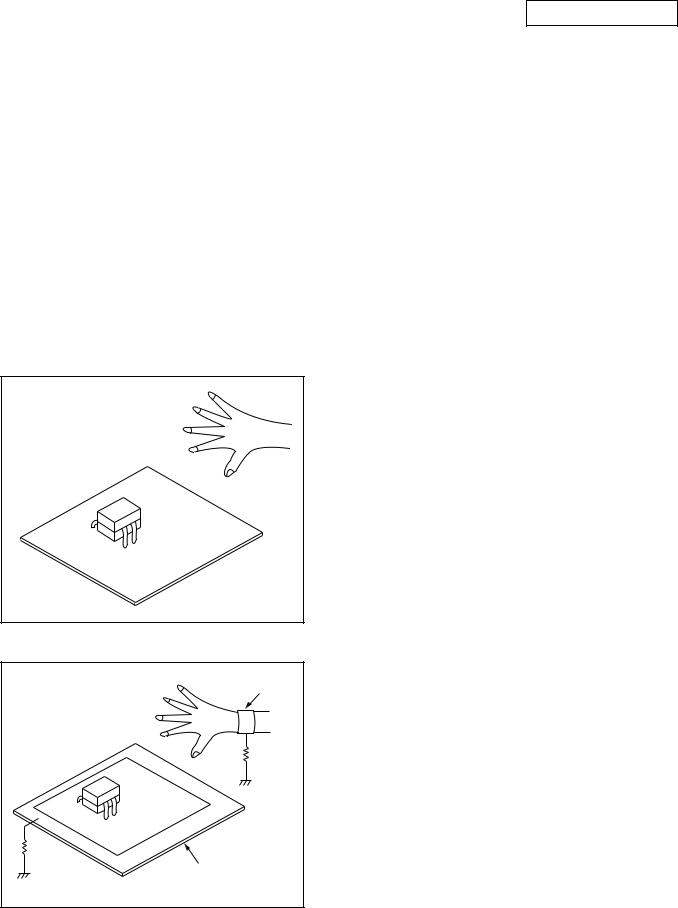
DVD-1910/755
Instructions for Handling
Semi-conductors
Electrostatic breakdown of the semi-conductors may occur due to a potential difference caused by electrostatic charge during unpacking or repair work.
1. Ground for Human Body
Be sure to wear a grounding band (1MΩ) that is properly grounded to remove any static electricity that may be charged on the body.
2. Ground for Workbench
(1)Be sure to place a conductive sheet or copper plate with proper grounding (1MΩ) on the workbench or other surface, where the semi-conductors are to be placed. Because the static electricity charge on clothing will not escape through the body grounding band, be careful to avoid contacting semi-conduc- tors with your clothing.
<Incorrect> |
|
|
CBA |
<Correct> |
Grounding Band |
|
1MΩ |
|
CBA |
1MΩ |
|
Conductive Sheet or
Copper Plate
10

DVD-1910/755
CABINET DISASSEMBLY INSTRUCTIONS
1. Disassembly Flowchart
This flowchart indicates the disassembly steps to gain access to item(s) to be serviced. When reassembling, follow the steps in reverse order. Bend, route, and dress the cables as they were originally.
|
[1] Top Cover |
|
|
|
|
||
|
|
|
|
|
|
|
|
|
|
|
|
|
|
|
|
|
|
|
|
|
|
|
|
|
[2] Front Unit |
|
|
[3] Function CBA |
|||
|
|
||||||
|
|
|
|
|
|
|
|
|
|
|
|
|
|
|
|
|
|
|
|
|
|
|
|
|
[5] Rear Panel |
|
|
|
[4] Front Assembly |
||
|
|
|
|
|
|
|
|
|
|
|
|
|
|
|
|
[6]DVD Main CBA Unit
[7]DVD Mecha
[8]LED CBA
[9]AV CBA
[10] Loader Base |
|
[11] Power PCB Holder |
|
|
|
2. Disassembly Method
ID/ |
|
|
REMOVAL |
|
|
|
|
REMOVE/*UNHOOK/ |
|
||
LOC. |
PART |
Fig. |
|
||
UNLOCK/RELEASE/ |
Note |
||||
No. |
|
||||
|
|
No. |
UNPLUG/DESOLDER |
|
|
|
|
|
|
|
|
[1] |
Top Cover |
D1 |
5(S-1) |
- |
|
|
|
|
|
1 |
|
|
|
|
|
1-1 |
|
|
|
|
*2(L-1), Tray Panel, |
1-2 |
|
|
|
|
1-3 |
||
[2] |
Front Unit |
D2 |
*2(L-2), *3(L-3), |
||
1-4 |
|||||
|
|
|
*CN2081 |
||
|
|
|
1-5 |
||
|
|
|
|
||
|
|
|
|
1-6 |
|
|
|
|
|
1-7 |
|
[3] |
Function |
D3 |
6(S-2) |
- |
|
CBA |
|||||
|
|
|
|
||
[4] |
Front |
D3 |
---------- |
- |
|
Assembly |
|||||
|
|
|
|
||
[5] |
Rear Panel |
D4 |
6(S-3), 3(S-4), 2(S-5) |
- |
|
|
DVD Main |
|
(S-6), |
2 |
|
[6] |
D5 |
*CN201, *CN301, |
2-1 |
||
CBA Unit |
|||||
|
|
*CN401, *CN601 |
2-2 |
||
|
|
|
|||
|
|
|
|
|
|
[7] |
DVD Mecha |
D5 |
4(S-7) |
2 |
|
D6 |
3 |
||||
|
|
|
|
|
|
[8] |
LED CBA |
D7 |
*CN2082 |
- |
|
|
|
|
|
|
|
[9] |
AV CBA |
D7 |
3(S-8), (S-9) |
- |
|
|
|
|
|
|
|
[10] |
Loader Base |
D8 |
4(S-10) |
- |
|
|
|
|
|
|
|
[11] |
Power PCB |
D8 |
2(S-11) |
- |
|
|
Holder |
|
|
|
|
↓ |
↓ |
↓ |
↓ |
↓ |
|
(1) |
(2) |
(3) |
(4) |
(5) |
(1): Identification (location) No. of parts in the figures (2): Name of the part
(3): Figure Number for reference
(4): Identification of parts to be removed, unhooked, unlocked, released, unplugged, unclamped, or desoldered.
P=Spring, L=Locking Tab, S=Screw, CN=Connector
*=Unhook, Unlock, Release, Unplug, or Desolder e.g. 2(S-2) = two Screws (S-2),
2(L-2) = two Locking Tabs (L-2) (5): Refer to “Reference Notes.”
About tightening screws
When tightening screws, tighten them with the following torque.
Screws |
Torque |
|
|
|
|
(S-1), (S-2), (S-3), (S-4), |
|
(S-5), (S-6), (S-7), (S-8), |
0.45 ± 0.05 N·m |
(S-9), (S-10), (S-11) |
|
|
|
Reference Notes
CAUTION 1: Locking Tabs (L-1), (L-2) and (L-3) are fragile. Be careful not to break them.
1-1. Connect the wall plug to an AC outlet and press the [OPEN/CLOSE] button to open the tray.
1-2. Remove the Tray Panel by releasing two locking tabs (L-1).
1-3. Press the [OPEN/CLOSE] button again to close the tray.
1-4. Press the [POWER] button to turn the power off. 1-5. Unplug an AC cord.
1-6. Disconnect connector CN2081.
1-7. Release two Locking Tabs (L-2). Then release three Locking Tabs (L-3), and remove the Front Unit.
CAUTION 2: Electrostatic breakdown of the laser diode in the optical system block may occur as a potential difference caused by electrostatic charge accumulated on cloth, human body etc, during unpacking or repair work.
To avoid damage of pickup follow next procedures.
2-1. Short the three short lands of FPC cable with solder before removing the FFC cable (CN201) from it. If you disconnect the FFC cable (CN201), the laser diode of pickup will be destroyed. (Fig. D4)
2-2. Disconnect Connectors (CN301), (CN401) and (CN601). Remove a Screw (S-6) and lift the DVD Main CBA Unit. (Fig. D4)
11

CAUTION 3: When reassembling, confirm the FFC cable (CN201) is connected completely. Then remove the solder from the three short lands of FPC cable. (Fig. D4)
(S-1) |
[1] Top Cover |
|
(S-1) |
|
(S-1) |
|
Fig. D1 |
Tray Panel |
|
(L-1) |
|
(L-1) |
|
(L-2) |
|
|
(L-2) |
|
CN2081 |
(L-3) |
[2] Front Unit |
|
|
|
Fig. D2 |
|
DVD-1910/755 |
[3] Function CBA |
(S-2) |
|
(S-2) |
[4] Front Assembly |
|
|
Fig. D3 |
[5] Rear Panel |
|
(S-4) |
|
(S-3) |
(S-3) |
(S-5) |
|
|
(S-4) |
Fig. D4 |
|
12
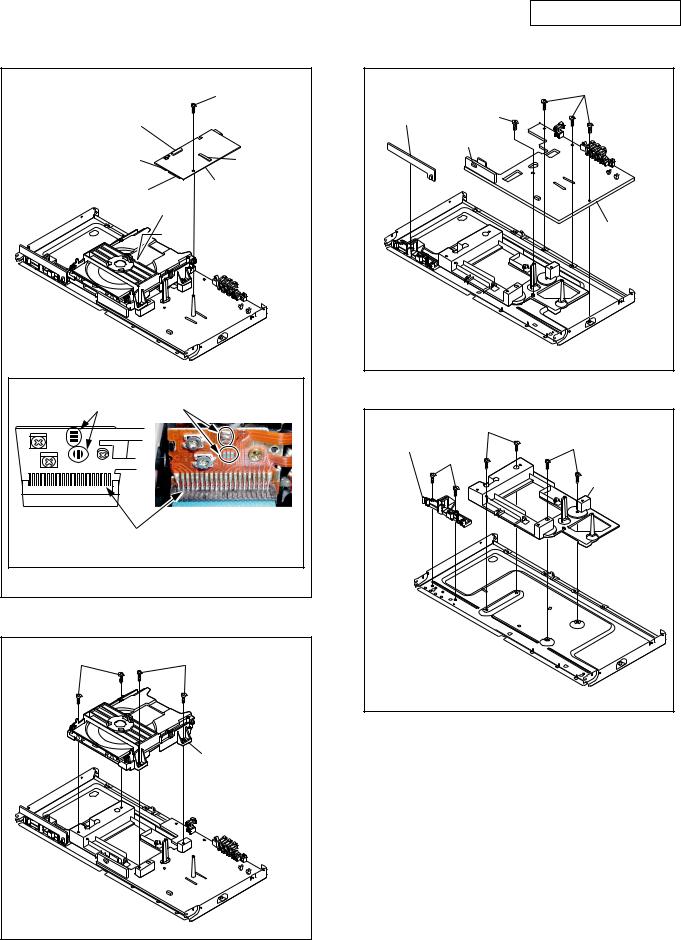
|
|
(S-6) |
CN201 |
|
|
CN301 |
|
CN601 |
CN401 |
|
[6] DVD Main |
|
A |
CBA Unit |
|
|
Short the three short lands by soldering. (Either of two places.)
Connector
View for A
Fig. D5
(S-7) |
(S-7) |
|
[7] DVD Mecha |
|
Fig. D6 |
|
DVD-1910/755 |
|
(S-8) |
[8] LED CBA |
(S-9) |
CN2082 |
|
|
[9] AV CBA |
|
Fig. D7 |
[11] Power |
(S-10) |
PCB Holder |
(S-10) |
(S-11) |
[10] Loader |
|
|
|
Base |
|
Fig. D8 |
13
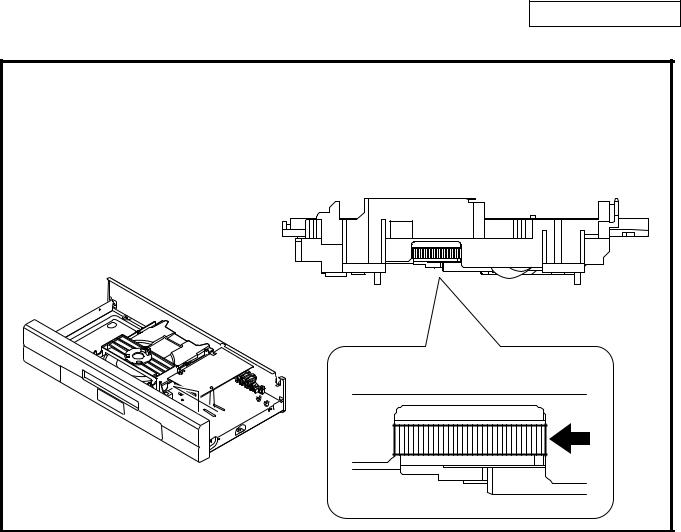
DVD-1910/755
HOW TO EJECT MANUALLY
1.Remove the Top Cover.
2.Rotate the roulette in the direction of the arrow as shown below.
View for A
Rotate this roulette in the direction of the arrow
A
14
